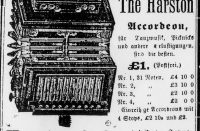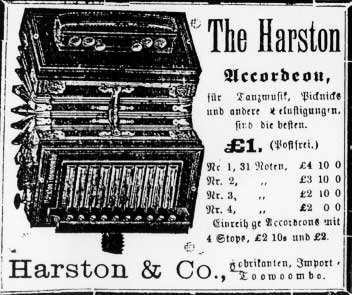Button Accordian Styles of the Vienna system button accordian (C, G, C-F, G-C, A-D, G-C-F etc)
After many years closely observing many traditional diatonic button accordion players throughout eastern Australia and parts of South Australia, with a particular emphasis on southern Queensland it was possible to reach some conclusions based on the instrument, playing style and geographic region/settlement origins.
Three basic ‘styles’ were observed, and in players of German descent in southern Queensland either all or some of the cross-rowing technique were always evident – particularly an almost obsessive emphasis on harmony.
These three playing styles are detailed below:
1. ‘Southern’ Australian Style (Anglo-Celtic derived)(one-row instruments or played restricted to a single key row on a multi-row diatonic instrument)
a) Melody Line Only: Tune is , playing single notes at a time
b) One row only : played using in and out bellows movements on one row. If the player has a three-row accordian, only one row of the accordian is used at a time.
c) Grace Notes such as triplets, acciacaturas may embellish the tune
d) Simple Bass Chording using only tonic and dominant to impart rhythm rather than harmony
e) Rhythm Notes may be added which are more staccato and often secondary to the main melody. These notes may be thirds, sixths or octaves
f) Octaves may be played with the first and fourth fingers simultaneously.
Sophisticated players may use all these styles simultaneously. “Battlers” use only melody and bass chords. The late Victorian player Harry McQueen and the NSW player Dave Mathias and the Holland family were both very fine single-row players. Their music can be heard in the National Library of Australia recordings and on the NLA CD ‘A Shared Harvest’.
2. Queensland Cross-Row Style (European derived) (two- or three-row)
a) Harmony notes : two, three or four notes played simultaneously with the melody. Usually thirds, sixths, fourths or octaves are used.
b) Cross-rowing: Instead of pulling the bellows the opposite way to obtain the next note in a scale, notes on a different row but in the same bellows direction are sought to make “runs”. Rather than the somewhat staccato effect obtained from Southern Australian Style, cross-rowing allows smooth, legato style in runs.
c) Rhythm notes in harmony with the melody may be added.
d) Extensive use of the Subdominant Chord. Sophisticated players like Alf Radunzmay use every chord on their instrument.
Examples of great cross-row players include Billy Fechner who crosses three rows, Alf Radunz and Paddy Pokarier on the double row. Modern Slovene Steirische ‘harmonika’ (diatonic multi-row button accordions) accordian players use this technique with great sophistication.
3. Intermediate “Borrowed Notes” Style.
The melody line is usually on one row, but where sharps or flats are required the appropriate not is borrowed from another row. This latter style is found throughout Australia and is a style used by sophisticated ‘anglo’ players. Players who use the chromatic C/C# instruments also ‘borrow’ notes from the ‘other’ row.




